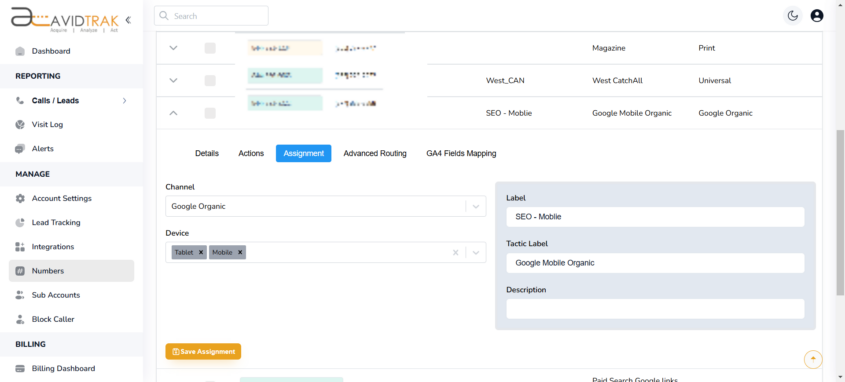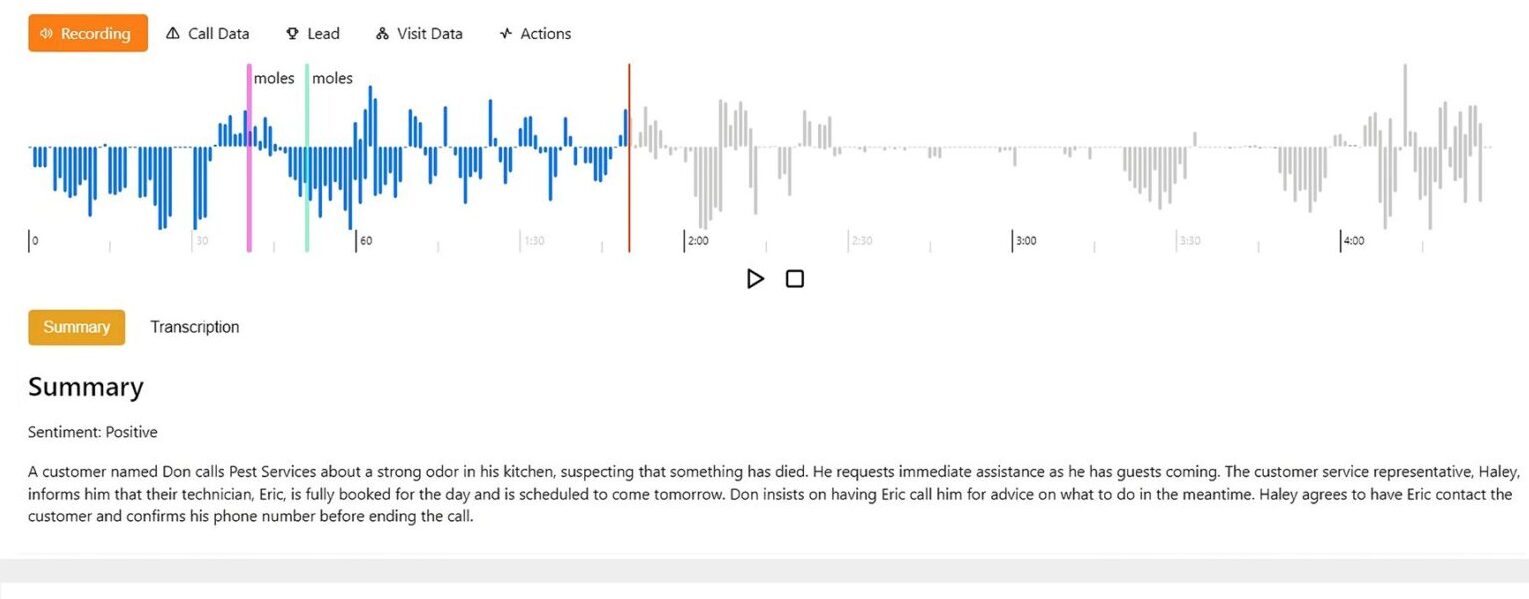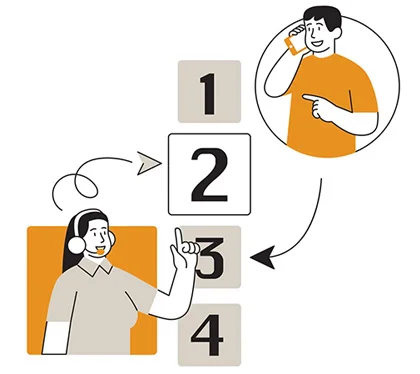Many businesses receive inbound phone calls every day, yet lack clarity on which marketing channel, keyword, or campaign prompted each conversation. Industries such as healthcare, legal, and home services rely heavily on phone calls, where around 60% of local search users prefer calling over submitting online forms or using live chat.
Call attribution is essential for identifying which marketing efforts generate qualified leads and for budget allocation. Without complete conversion tracking or accurate customer journey data, it is difficult to objectively evaluate campaign performance and accurately measure cost per lead.
This guide explains how call attribution supports performance marketing, outlines the tools and models that make it effective, and shows how AvidTrak’s call tracking platform links every inbound call to real outcomes at a competitive price and with expert support built in.
Summary
- Call attribution connects each phone call to the specific marketing channel or campaign that led to the call, providing real data to measure performance.
- Phone calls are still among the highest intent conversions, especially in healthcare, legal services, and home improvement sectors.
- Call attribution includes tracking numbers, dynamic number insertion, call routing, call recording, and analytics to reveal lead details.
- Attribution models such as first touch, last touch, linear, time decay, and data-driven help assign credit based on how each step influences the customer journey.
- Channels that commonly drive calls include Google Ads, Meta Ads, SEO landing pages, Google Business Profile listings, print or radio ads, and targeted email campaigns.
- Important metrics to review are call volume, qualified call rate, call conversion rate, cost per call, and revenue per call.
- Frequent mistakes include relying on one static tracking number, skipping CRM integration, ignoring mobile-friendly call behavior, and missing detailed call outcome tagging.
- Affordable pricing, exceptional and timely product support, and deep experience make AvidTrak a trusted choice for call attribution. AvidTrak combines tracking numbers, dynamic number insertion, advanced routing, call recording, AI-powered transcription, and clean integrations with analytics and CRM systems to help teams track every call and connect results directly to revenue.
What Is Call Attribution?
Call attribution is the process of linking inbound phone calls to the specific marketing channel or campaign that generated the call. This type of attribution is especially critical for service-based and local businesses that rely on phone conversations to convert leads.
AvidTrak’s call attribution software offers campaign-level visibility, allowing teams to accurately trace each call back to its source, unlike click attribution, which only tracks form submissions or page views.
When a user clicks a Google Ads link, lands on a website, and places a call, AvidTrak ties that call to the specific ad and keyword that triggered the action. The process relies on tools such as unique tracking numbers, Dynamic Number Insertion (DNI), and consistent source tagging.
Why Call Attribution Matters in 2025
Many teams still prioritize digital clicks and online forms, even though phone calls often lead to stronger customer engagement and better sales outcomes. In service industries where trust and quick decisions matter, conversations drive more value than passive form submissions.
AvidTrak uses affordable tracking numbers, AI-powered transcription, and flexible attribution models, helping marketing teams to allocate spend more effectively and prioritize the channels that drive consistent performance.
Calls Are Still High-Intent Conversions
Phone calls remain the clearest sign of intent in the legal, dental, and home services industries. Many customers prefer speaking to someone directly to get quick answers.
Calls convert faster than forms and bring higher conversion rates, especially when unique phone numbers and proper call tracking link every conversation to the right marketing channel.
Blind Spots Kill Ad ROI
Budgets often go to waste when calls are not properly connected to ads and keywords. A strong call attribution setup uses dynamic number insertion and clear call outcomes to match every call to its source.
Integrating AvidTrak with platforms such as Google Ads and GA4 helps focus budget on campaigns that drive measurable results.
Offline and Clickless Conversions Are Rising
Privacy regulations and limited click tracking have increased the number of calls that originate directly from sources such as Google Business Profile, print ads, or word-of-mouth. Tracking and attributing offline conversations to the correct marketing source maintains visibility into the customer journey and ensures accurate credit for conversions.
How Call Attribution Works
Understanding how call attribution works helps businesses connect calls to real results using real data. The process uses a few simple parts that work together:
-
Tracking numbers
Local or toll-free numbers assigned to each marketing channel or ad make it easy to link calls directly to specific campaigns.
-
Dynamic Number Insertion (DNI)
Numbers shown on your website adjust automatically based on where visitors arrive from, such as Google Ads, email campaigns, or social media.
-
Call routing and forwarding
Calls reach the right department or customer service representatives, ensuring inquiries are handled quickly and routed accurately.
-
Recording and analytics
Each call is recorded, outcomes are tagged, and all details tie back to conversion tracking and the customer journey for clear and accurate reporting.
Reliable platforms like AvidTrak’s call-tracking software handle every part of this process smoothly, from assigning tracking numbers to recording call outcomes and syncing data with your ad platforms. Accurate attribution helps teams spend wisely, handle more qualified calls, and pinpoint which campaigns drive revenue.
Types of Call Attribution Models
Selecting the right attribution model aligns each call with the appropriate stage of the customer journey, defining how conversion credit is assigned and enabling more accurate budget planning.
Here’s a quick look at standard models:
| Model | Description | Best For |
| First-Touch | Assigns credit to the first marketing channel, for example, a customer interacts with a Facebook ad. | Awareness campaigns and top-of-funnel tracking. |
| Last-Touch | Credits the last source before the call, often a Google Ads click. | Finding the strongest direct call drivers. |
| Linear | Shares credit equally across all steps. | Tracking multi-channel conversion paths. |
| Time-Decay | Gives more weight to steps closest to the call. | Longer sales funnel cycles with many touches. |
| Data-Driven | Uses machine learning to assign value based on real patterns. | Advanced teams wanting custom or algorithmic attribution. |
Teams that use AvidTrak can apply different attribution models, compare outcomes, and adjust their strategies as needed. Custom dashboards and clear reports reveal which channels generate the most valuable calls, helping to reduce wasted spend.
Common Channels That Drive Calls (And How to Attribute Them)
Most businesses get calls from paid ads, organic search, and offline promotions, and knowing which channels deliver the most calls helps tighten budgets and improve ROI. Here’s how strong call attribution keeps every source clear:
-
Google Ads
Call extensions or call-only ads make it easy for search users to call directly from results, while pairing ads with dynamic number insertion connects each click to a unique number and tracks specific keywords.
-
Meta Ads
Click-to-call buttons on Facebook and Instagram encourage immediate calls from mobile users, with each ad group assigned a unique tracking number to accurately measure the performance of every creative.
-
SEO Landing Pages
A visible phone number near the top of high-converting pages helps organic visitors connect quickly. Dynamic numbers reveal which keywords or pages lead to the most calls.
-
Google Business Profile / Maps
Local searches often result in direct calls from Maps listings. Tracking numbers assigned to each location tie these calls back to the correct stage in the customer journey.
-
Print Ads, Radio, Flyers
Offline marketing remains an effective strategy for reaching local audiences. Dedicated toll-free or local numbers for each ad or flyer ensure clear and accurate response measurement.
-
Email or SMS Campaigns
Clickable phone numbers in email or text campaigns provide a quick way for customers to connect. Tracking links each number to the exact campaign and audience segment.
AvidTrak consolidates all these channels into a single, clear system. Teams can assign numbers for each source, send calls to the right people, and track results to the last dollar spent.
Key Metrics to Track in Call Attribution
Call attribution depends on tracking the metrics that reflect real performance. Focusing on what drives value, beyond call volume, helps keep ad spend aligned with results.
-
Call volume by source or campaign
Provides a clear view of which marketing channels and ads generate the highest number of calls and also pinpoints less effective channels and ads.
-
Qualified call rate
Indicates the number of calls that meet sales criteria for follow-up. Longer call durations and AI-powered transcription add context to confirm caller intent and filter out low-quality leads.
-
Call conversion rate
Shows the percentage of calls that turn into booked appointments, confirmed orders, or closed deals instead of remaining as inquiries.
-
Cost per call and cost per lead
Calculates the budget spent to bring in each qualified call or lead, supporting better planning and spending control.
-
Missed and answered calls
Reveals how well the sales team manages incoming calls and highlights patterns that may point to lost opportunities if calls go unanswered.
-
Revenue per call
Links each call directly to actual sales revenue, helping teams identify which calls and campaigns deliver the highest profit.
Consistently tracking campaigns, keywords, and caller behavior helps confirm which marketing tactics drive results.
Common Call Attribution Mistakes to Avoid
Many marketing teams overlook key elements of call attribution in performance campaigns, and even small tracking gaps can lead to inaccurate costs and missed conversions. Below are common issues that affect data quality and budget decisions:
- Using the same static number for every campaign hides which marketing channel or ad generated the call.
- Not counting calls as conversions in Google Ads leaves gaps in data and makes it harder to measure actual return on ad spend.
- Skipping CRM integration breaks the link between call leads, sales results, and the complete customer journey.
- Ignoring mobile-first behavior overlooks how many people prefer click-to-call options; ads and pages should simplify calling.
- Lacking after-hours routing or voicemail means unanswered calls outside business hours often cost revenue and waste media spend.
- Not using speech analysis or IVR features to tag call outcomes makes it harder to track lead quality accurately.
Addressing these gaps ensures that every call is accurately tracked, every lead is followed up on, and marketing budgets are focused on strategies that deliver real results.
How AvidTrak Simplifies Call Attribution
AvidTrak simplifies call attribution with clear, budget-friendly solutions. Years of expertise and strong product support ensure teams can trust their data, avoid wasteful spending, and measure performance accurately.
Every phone call ties back to proper marketing channels, with clean data feeding directly into analytics and CRM systems. Reliable tracking and smart routing keep the sales funnel steady, showing exactly where calls turn into revenue.
Dynamic Number Insertion
 AvidTrak’s dynamic number insertion swaps out phone numbers on websites and landing pages based on the visitor’s source. Each campaign and keyword can have its unique number, making it simple to see which ads and search terms bring in the most calls.
AvidTrak’s dynamic number insertion swaps out phone numbers on websites and landing pages based on the visitor’s source. Each campaign and keyword can have its unique number, making it simple to see which ads and search terms bring in the most calls.
Call Recording and AI-Powered Transcription
 Calls are recorded and transcribed automatically, helping sales teams check what was said and qualify leads faster. AI tagging picks up keywords and caller intent, which supports cleaner conversion tracking and improves customer journey data.
Calls are recorded and transcribed automatically, helping sales teams check what was said and qualify leads faster. AI tagging picks up keywords and caller intent, which supports cleaner conversion tracking and improves customer journey data.
IVR and Smart Routing
 An interactive voice menu and smart routing ensure calls are directed to the right team, whether it’s sales, service, or a local branch.
An interactive voice menu and smart routing ensure calls are directed to the right team, whether it’s sales, service, or a local branch.
Integrations with Google Ads, GA4, and CRMs
 Direct connections with Google Ads, Google Analytics 4, and major CRMs link every call outcome and cost detail to other campaign metrics, allowing teams to view full performance in one place without switching between multiple platforms.
Direct connections with Google Ads, Google Analytics 4, and major CRMs link every call outcome and cost detail to other campaign metrics, allowing teams to view full performance in one place without switching between multiple platforms.
Real-Time Dashboards and Reports
 Reports update in real-time and show which campaigns, ads, and keywords bring calls that lead to revenue. Clear dashboards support faster budget changes and sharper decisions without waiting for lengthy monthly summaries.
Reports update in real-time and show which campaigns, ads, and keywords bring calls that lead to revenue. Clear dashboards support faster budget changes and sharper decisions without waiting for lengthy monthly summaries.
Speech Analytics to Filter Spam
 Speech analysis tools review calls for spam or low-quality leads and separate them from true opportunities. Accurate filters help maintain a realistic cost per lead and support better return on ad spend.
Speech analysis tools review calls for spam or low-quality leads and separate them from true opportunities. Accurate filters help maintain a realistic cost per lead and support better return on ad spend.
Call Attribution + Multi-Touch Performance Marketing
Strong call attribution performance marketing works best as part of a complete multi-touch strategy. Calls often follow a series of interactions across different marketing channels, not just a single ad or page.
Combining call tracking with other touchpoints builds a clearer picture of the full customer journey. Key touchpoints to connect include:
-
On-site events
Includes actions such as form submissions, button clicks, and page views that add context to call data and show how visitors interact before deciding to call.
-
Email opens
Shows the role email campaigns play in driving calls and repeat visits, adding another touchpoint to the full customer journey.
-
Retargeting ad views
Highlights how repeated ad exposure keeps the brand visible and encourages potential customers to call after seeing reminders across channels.
-
Organic search and Google Business Profile Traffic
Combines SEO performance and local search activity with call tracking to provide stronger local attribution and more precise results from unpaid traffic.
Linking calls with clicks, site actions, and ads ensures clean cross-channel reporting. With accurate data, teams choose the right attribution model, plan spending wisely, and trust results when reviewing return on ad spend.
Turn Every Call Into Proven Revenue With AvidTrak
Stop wasting your budget on ads that don’t convert. AvidTrak keeps call attribution performance marketing simple, affordable, and backed by real support and proven expertise in handling complex tracking needs.
Start tracking every phone call, link it to your best marketing channels, and plan spending with confidence.
Start your free trial today and see how clear call data powers better decisions.
Frequently Asked Questions
1. How does call attribution help measure ROI more accurately?
Call attribution connects every phone call to a clear marketing channel and keyword, so teams can track true lead costs and plan return on ad spend with real data. AvidTrak reports make this easy to see at a glance.
2. Can call attribution work for both online and offline campaigns?
Yes. With AvidTrak, tracking numbers capture calls from digital channels like Google Ads and SEO pages and offline channels like flyers, print, or radio ads, all in one place.
3. What’s the difference between single-touch and multi-touch call attribution?
Single-touch attribution credits just one point in the customer journey, such as the first click or final ad. Multi-touch attribution shares credit across all steps, so teams can see how clicks, site visits, and calls connect to a final conversion.
4. How does AI-powered transcription improve lead quality checks?
AvidTrak’s transcription automatically tags key phrases and caller intent, so teams can spot strong leads faster without listening to every recording. Transcription keeps conversion tracking accurate and saves time.
5. What role does speech analytics play in call tracking?
Speech analytics reviews conversations to filter spam or accidental calls and highlight real intent. AvidTrak uses this to keep the cost per lead realistic and focus budgets on genuine opportunities.
6. How do missed call alerts help improve performance marketing?
Missed call alerts from AvidTrak notify teams immediately when a call goes unanswered. Fast follow-ups help recover leads that could have been lost and keep the sales funnel full.
7. Can I track which keywords drive the most phone leads?
Absolutely. AvidTrak uses campaign-level call attribution and dynamic number insertion to give each keyword a unique number, showing which search terms produce the best calls and sales results.


